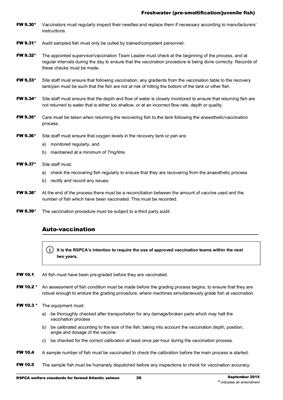
Freshwater (pre-smoltification/juvenile fish)
RSPCA welfare standards for farmed Atlantic salmon 30 September 2015
* indicates an amendment
FW 9.30* Vaccinators must regularly inspect their needles and replace them if necessary according to manufacturers'
instructions.
FW 9.31* Audit sampled fish must only be culled by trained/competent personnel.
FW 9.32* The appointed supervisor/vaccination Team Leader must check at the beginning of the process, and at
regular intervals during the day to ensure that the vaccination procedure is being done correctly. Records of
these checks must be made.
FW 9.33* Site staff must ensure that following vaccination, any gradients from the vaccination table to the recovery
tank/pen must be such that the fish are not at risk of hitting the bottom of the tank or other fish.
FW 9.34* Site staff must ensure that the depth and flow of water is closely monitored to ensure that returning fish are
not returned to water that is either too shallow, or at an incorrect flow rate, depth or quality.
FW 9.35* Care must be taken when returning the recovering fish to the tank following the anaesthetic/vaccination
process.
FW 9.36* Site staff must ensure that oxygen levels in the recovery tank or pen are:
a) monitored regularly, and
b) maintained at a minimum of 7mg/litre.
FW 9.37* Site staff must:
a) check the recovering fish regularly to ensure that they are recovering from the anaesthetic process
b) rectify and record any issues.
FW 9.38* At the end of the process there must be a reconciliation between the amount of vaccine used and the
number of fish which have been vaccinated. This must be recorded.
FW 9.39* The vaccination procedure must be subject to a third party audit.
Auto-vaccination
It is the RSPCA's intention to require the use of approved vaccination teams within the next
two years.
FW 10.1 All fish must have been pre-graded before they are vaccinated.
FW 10.2 * An assessment of fish condition must be made before the grading process begins, to ensure that they are
robust enough to endure the grading procedure, where machines simultaneously grade fish at vaccination.
FW 10.3 * The equipment must:
a) be thoroughly checked after transportation for any damage/broken parts which may halt the
vaccination process
b) be calibrated according to the size of the fish, taking into account the vaccination depth, position,
angle and dosage of the vaccine
c) be checked for the correct calibration at least once per hour during the vaccination process.
FW 10.4 A sample number of fish must be vaccinated to check the calibration before the main process is started.
FW 10.5 The sample fish must be humanely dispatched before any inspections to check for vaccination accuracy.
i